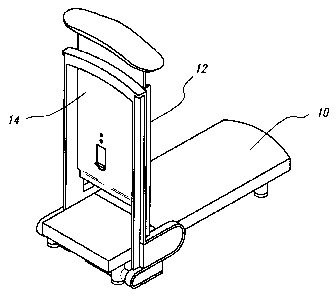Some of the information on this Web page has been provided by external sources. The Government of Canada is not responsible for the accuracy, reliability or currency of the information supplied by external sources. Users wishing to rely upon this information should consult directly with the source of the information. Content provided by external sources is not subject to official languages, privacy and accessibility requirements.
Any discrepancies in the text and image of the Claims and Abstract are due to differing posting times. Text of the Claims and Abstract are posted:
| (12) Patent: | (11) CA 2158311 |
|---|---|
| (54) English Title: | CHEESE SLICER |
| (54) French Title: | TRANCHE-FROMAGE |
| Status: | Expired and beyond the Period of Reversal |
| (51) International Patent Classification (IPC): |
|
|---|---|
| (72) Inventors : |
|
| (73) Owners : |
|
| (71) Applicants : |
|
| (74) Agent: | OYEN WIGGS GREEN & MUTALA LLP |
| (74) Associate agent: | |
| (45) Issued: | 2007-09-11 |
| (22) Filed Date: | 1995-09-15 |
| (41) Open to Public Inspection: | 1996-03-17 |
| Examination requested: | 2002-08-23 |
| Availability of licence: | N/A |
| Dedicated to the Public: | N/A |
| (25) Language of filing: | English |
| Patent Cooperation Treaty (PCT): | No |
|---|
| (30) Application Priority Data: | ||||||
|---|---|---|---|---|---|---|
|
A cheese slicer having a flat base and a blade holder releasably pivotally secured to the base for moving from a locked upright cheese slicing position to a lowered storing position. A unique wide, flat blade slidably carried in the blade holder and having an upper end with a large handle and a lower end. The lower end having a downwardly and rearwardly sloping separating surface terminating in a downwardly protruding blunt slicing edge.
Un tranche-fromage doté d'une base plate et d'un porte-lame pivotant rétractable fixé à la base pour se déplacer à partir de la position verrouillée de tranchage du fromage à la position couchée pour le rangement. La lame, droite et large, se glisse dans le porte-lame et est munie d'une extrémité supérieure dotée d'une grande poignée et d'une extrémité inférieure. L'extrémité inférieure est pourvue d'une surface de séparation courbée vers le bas et l'arrière qui se termine par une extrémité tranchante protubérante.
Note: Claims are shown in the official language in which they were submitted.
Note: Descriptions are shown in the official language in which they were submitted.

2024-08-01:As part of the Next Generation Patents (NGP) transition, the Canadian Patents Database (CPD) now contains a more detailed Event History, which replicates the Event Log of our new back-office solution.
Please note that "Inactive:" events refers to events no longer in use in our new back-office solution.
For a clearer understanding of the status of the application/patent presented on this page, the site Disclaimer , as well as the definitions for Patent , Event History , Maintenance Fee and Payment History should be consulted.
| Description | Date |
|---|---|
| Time Limit for Reversal Expired | 2013-09-17 |
| Letter Sent | 2012-09-17 |
| Grant by Issuance | 2007-09-11 |
| Inactive: Cover page published | 2007-09-10 |
| Pre-grant | 2007-06-20 |
| Inactive: Final fee received | 2007-06-20 |
| Inactive: Office letter | 2007-01-29 |
| Inactive: Entity size changed | 2007-01-24 |
| Letter Sent | 2007-01-16 |
| Notice of Allowance is Issued | 2007-01-16 |
| Notice of Allowance is Issued | 2007-01-16 |
| Inactive: Corrective payment - s.78.6 Act | 2007-01-15 |
| Inactive: Approved for allowance (AFA) | 2007-01-05 |
| Amendment Received - Voluntary Amendment | 2006-07-28 |
| Inactive: Office letter | 2006-06-12 |
| Inactive: Adhoc Request Documented | 2006-05-02 |
| Inactive: Delete abandonment | 2006-05-02 |
| Inactive: IPC from MCD | 2006-03-11 |
| Inactive: IPC from MCD | 2006-03-11 |
| Inactive: IPC from MCD | 2006-03-11 |
| Inactive: Delete abandonment | 2006-02-22 |
| Inactive: S.30(2) Rules - Examiner requisition | 2006-02-20 |
| Inactive: Abandoned - No reply to s.30(2) Rules requisition | 2005-10-07 |
| Amendment Received - Voluntary Amendment | 2005-10-07 |
| Inactive: S.30(2) Rules - Examiner requisition | 2005-04-07 |
| Inactive: S.30(2) Rules - Examiner requisition | 2005-04-07 |
| Inactive: Status info is complete as of Log entry date | 2002-09-09 |
| Letter Sent | 2002-09-09 |
| Inactive: Application prosecuted on TS as of Log entry date | 2002-09-09 |
| All Requirements for Examination Determined Compliant | 2002-08-23 |
| Request for Examination Requirements Determined Compliant | 2002-08-23 |
| Inactive: Abandoned - No reply to s.30(2) Rules requisition | 2002-08-20 |
| Inactive: S.30(2) Rules - Examiner requisition | 2002-02-20 |
| Inactive: Adhoc Request Documented | 2002-02-20 |
| Application Published (Open to Public Inspection) | 1996-03-17 |
There is no abandonment history.
The last payment was received on 2007-08-20
Note : If the full payment has not been received on or before the date indicated, a further fee may be required which may be one of the following
Please refer to the CIPO Patent Fees web page to see all current fee amounts.
Note: Records showing the ownership history in alphabetical order.
| Current Owners on Record |
|---|
| CHEF'N CORPORATION |
| Past Owners on Record |
|---|
| BRADLEY BURTON LARSEN |
| DAVID HOLCOMB |